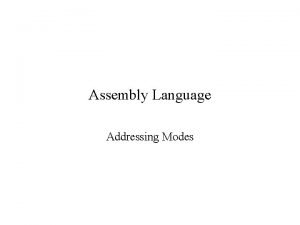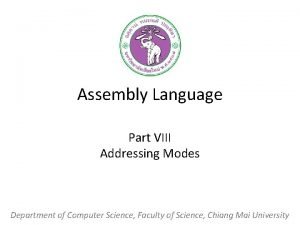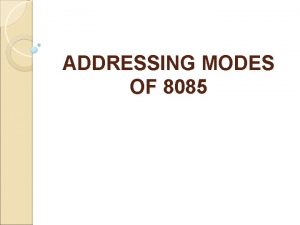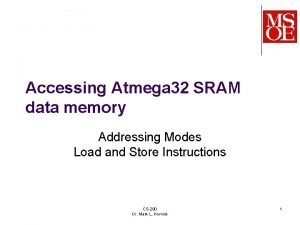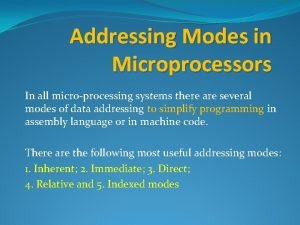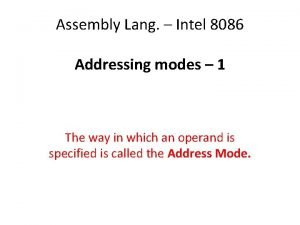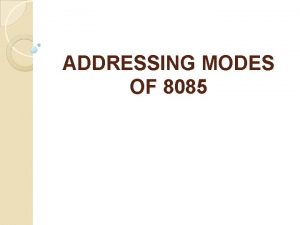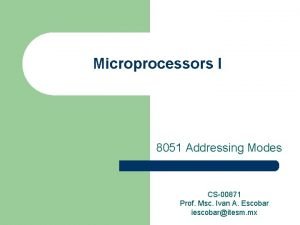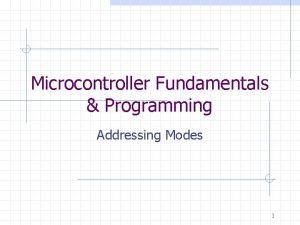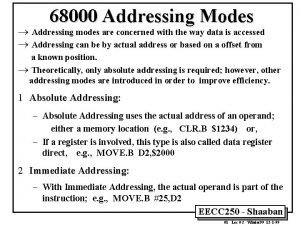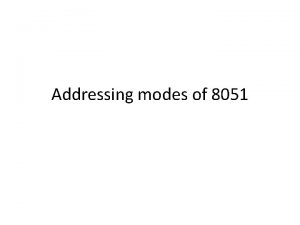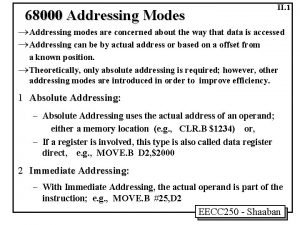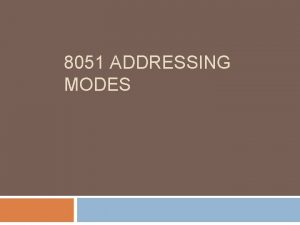Addressing Modes 1 DataAddressing Modes Instruction is divided




![MOV AL, DS: [123 A] memory AL EAX EBX ECX 5 B 4 B MOV AL, DS: [123 A] memory AL EAX EBX ECX 5 B 4 B](https://slidetodoc.com/presentation_image_h2/04c41350ef29349f92d08407015b5085/image-5.jpg)



![PROGRAM MEMORY-ADDRESSING MODES 1. 9 Direct Program Memory Addressing. JMP [10000 H] Opcode Offset(low) PROGRAM MEMORY-ADDRESSING MODES 1. 9 Direct Program Memory Addressing. JMP [10000 H] Opcode Offset(low)](https://slidetodoc.com/presentation_image_h2/04c41350ef29349f92d08407015b5085/image-9.jpg)
![3. Indirect Program Memory addressing. JMP AX JMP [BX] STACK MEMORY-ADDRESSING MODES. PUSH BX 3. Indirect Program Memory addressing. JMP AX JMP [BX] STACK MEMORY-ADDRESSING MODES. PUSH BX](https://slidetodoc.com/presentation_image_h2/04c41350ef29349f92d08407015b5085/image-10.jpg)
- Slides: 10

Addressing Modes 1. Data-Addressing Modes. Instruction is divided to two parts: Opcode ( operation code) tells the microprocessor which operation to perform. Operand, source and destination. 1

1. Register addressing. Transfers a copy of a byte or word from the source register or contents of a memory location to the destination register or memory location. MOV CX, DX MOV ECX, EDX MOV ES, DS (segment to segment) MOV CS, AX (code segment) MOV BL, DX 2 (mixed sizes) MOV BX, CX EBX B 1 D 6 76 FF ECX 11 AC 12 34 1234

2. Immediate addressing. Transfers the source (immediate byte or word data), into the destination register or memory location. MOV AL, 22 H MOV EBX, 12345678 H MOV EAX, 1234 H EAX ECX 3 B 1 D 6 76 FF

3. Direct addressing. Moves a byte or word between a memory location and a register. MOV CX, LIST MOV ESI, LIST a. Direct addressing (use AL, AX, and EAX), (three bytes long) MOV AX, NUMBER b. Displacement addressing ( almost any instruction in the instruction set), (four bytes long) MOV ES, DATA 4
![MOV AL DS 123 A memory AL EAX EBX ECX 5 B 4 B MOV AL, DS: [123 A] memory AL EAX EBX ECX 5 B 4 B](https://slidetodoc.com/presentation_image_h2/04c41350ef29349f92d08407015b5085/image-5.jpg)
MOV AL, DS: [123 A] memory AL EAX EBX ECX 5 B 4 B 1 D 6 76 FF B 4 123 B 123 A 1239

4. Register indirect addressing. Transfers a byte or word between a register and a memory location addressed by an index or base register. MOV AX, [BX] MOV AL, [ECX] in the 80386 and above, can address by any register (EAX, EBX, ECX, EDX, EBP, E DI, or ESI). 6

5. Base-plus-index addressing. Transfers a byte or word between a register and the memory location addressed by a base register (BP or BX) plus an index register (DI or SI). MOV [BX+DI], CL MOV [EAX+EBX], CL in the 80386 and above, any two registers (EAX, EBX, ECX, EDX, EBP, EDI, or ESI). 6. Register relative addressing. Moves a byte or word between a register and the memory location addressed by an index or base register plus a displacement. MOV AX, [BX+4] MOV AX, ARRAY[BX] MOV AX, [ECX+4] in 80386 and above, use any 32 -bit register except ESP. MOV AX, ARRAY[EBX] 7

7. Base relative – plus – index addressing. Transfers a byte or word between a register and memory location addressed by a base and an index register plus a displacement. MOV AX, [BX+DI+4] MOV AX, ARRAY[BX+DI] MOV EAX, ARRAY[EBX+ECX] 8. Scaled-index addressing. Available only in the 80386 and above. The second register of a pair of registers is modified by the scale factor of 2 x, 4 x, or 8 x to generate the operand memory address. MOV EDX, [EAX+4*EBX] Allows to access to word (2 x), doubleword ( 4 x), or quadword (8 x) memory array data. MOV AL, [2*EBX] 8
![PROGRAM MEMORYADDRESSING MODES 1 9 Direct Program Memory Addressing JMP 10000 H Opcode Offsetlow PROGRAM MEMORY-ADDRESSING MODES 1. 9 Direct Program Memory Addressing. JMP [10000 H] Opcode Offset(low)](https://slidetodoc.com/presentation_image_h2/04c41350ef29349f92d08407015b5085/image-9.jpg)
PROGRAM MEMORY-ADDRESSING MODES 1. 9 Direct Program Memory Addressing. JMP [10000 H] Opcode Offset(low) Offset(high) EA 00 00 Segment(low) Segment(high) 00 Relative Program Memory Addressing. JMP [2] 10000 EB 10001 10002 10003 10004 02 ----- 10
![3 Indirect Program Memory addressing JMP AX JMP BX STACK MEMORYADDRESSING MODES PUSH BX 3. Indirect Program Memory addressing. JMP AX JMP [BX] STACK MEMORY-ADDRESSING MODES. PUSH BX](https://slidetodoc.com/presentation_image_h2/04c41350ef29349f92d08407015b5085/image-10.jpg)
3. Indirect Program Memory addressing. JMP AX JMP [BX] STACK MEMORY-ADDRESSING MODES. PUSH BX POP AX 10 H-byte sp-1, L-byte sp-2 H-byte sp+1, L-byte sp
 Flat addressing vs hierarchical addressing
Flat addressing vs hierarchical addressing Addressing modes of 8086 microprocessor
Addressing modes of 8086 microprocessor Cisc addressing modes
Cisc addressing modes Mov a, 3000 h is legal illegal
Mov a, 3000 h is legal illegal Addressing modes of 8085
Addressing modes of 8085 Addressing modes of atmega32
Addressing modes of atmega32 Immediate addressing mode
Immediate addressing mode Addressing modes in microprocessor
Addressing modes in microprocessor Based addressing mode in 8086
Based addressing mode in 8086 8085 addressing modes
8085 addressing modes 8051 microcontroller addressing modes
8051 microcontroller addressing modes


